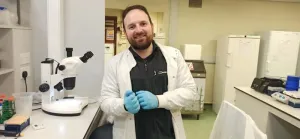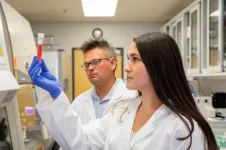In this retrospective study conducted between January 2017 and July 2020, researchers from UH Connor Whole Health examined the delivery and integration of music therapy across the UH health system and described the demographic and clinical characteristics of all hospitalized adults seen by the music therapy program outside of inpatient psychiatric or emergency departments. Overall, this large study examined 14,261 music therapy sessions provided to 7,378 unique patients who had been referred by 1,169 healthcare professionals within 10 UH medical centers over 3.5 years. This study builds upon a 30-year history of seminal music therapy studies at UH funded by the Kulas Foundation, the country’s leading private foundation for funding scientific research in music therapy. Kulas has funded studies at UH studying the efficacy of music therapy in palliative care, surgery, and sickle cell disease. The findings from the current study serve as the foundation for the EMMPIRE study led by researchers at UH Connor Whole Health. Other recent publications from the EMMPIRE dataset support the real-world clinical effectiveness of music therapy for addressing patients’ symptoms within community hospitals and at an academic cancer center.
“In addition to the size of the EMMPIRE dataset, this descriptive study is also novel in that it demonstrates our ability to use the electronic health record as a research tool. We also compared the characteristics of the population seen by music therapy to the UH population overall to demonstrate the integration of the music therapy program,” said Samuel Rodgers-Melnick, MPH, MT-BC, co-investigator for EMMPIRE and the lead author of the study.
To facilitate a comparison of the music therapy population with hospitalization trends reported by UH, the researchers separated the population into patients seen within Cuyahoga County hospitals (six mostly urban hospitals including the academic medical center in Cleveland) and patients seen in counties outside Cuyahoga County (four hospitals serving mostly rural areas). This analysis revealed similarities in demographic and clinical characteristics. For example, the percentage of patients seen by music therapy who identified as Black/African American within Cuyahoga County (48.0%) was reflective of the demographics of that county, where 48.3% of Cleveland (the largest city within Cuyahoga County) residents identify as Black/African American. Additionally, the distribution of medical populations seen by the music therapy team (i.e., cardiovascular, respiratory, and musculoskeletal) were similar to the rates reported by UH within and outside Cuyahoga County..
“Music therapy services are embedded across the UH healthcare system and integrated into frontline interdisciplinary teams caring for critically ill patients. We are committed to providing non-pharmacologic support to patients from diverse backgrounds for both physical and psychological vulnerabilities.” said Seneca Block, The Lauren Rich Fine Endowed Director of Expressive Therapies at UH Connor Whole Health and co-author of the study. UH Connor Whole Health manages the largest health system-based music therapy program in the US with 11 board-certified music therapists who collaborate with providers across the system to help patients and their families manage the physical and emotional toll of an illness or hospitalization. Additionally, UH Connor Whole Health provides a diverse offering of integrative health and medicine modalities, including acupuncture, chiropractic, and integrative medicine consults, that are centered on patients’ entire well-being.
Other important descriptive findings from the study include: (1) patients seen by music therapy were predominantly female (63.7%), White (54.3%) or Black/African American (44.0%), 63.7 ± 18.5 years of age at admission, and insured under Medicare (51.1%), Medicaid (18.1%) or private insurance (14.2%); (2) patients were referred by physicians (34.7%), nurses (29.4%), or advanced practice providers (24.7%) for coping (32.0%), anxiety reduction (20.4%), or pain management (10.1%); and (3) 39.4% of patients’ hospital admissions included a mental health diagnosis, a significantly higher rate than the average of 27.8% reported among all 2016 inpatient stays in the United States. “The strength of EMMPIRE and other real-world studies is the reliable documentation in the electronic health record by the integrative health and medicine providers on these interventions and patient-reported outcomes,” said Jeffery A. Dusek PhD, Director of Research, UH Connor Whole Health and Principal Investigator of EMMPIRE as well as the BraveNet Practice-Based Research Network, the largest such network of integrative health and medicine centers in the world.
You can read “Effectiveness of Medical Music Therapy Practice: Integrative Research using the Electronic Health Record (EMMPIRE): Rationale, Design, and Population Characteristics” in Journal of Integrative and Complementary Medicine by clicking here.
###
About UH Connor Whole Health
UH Connor Whole Health is part of University Hospitals (UH), a comprehensive health system with annual revenues in excess of $5.0 billion, 23 hospitals (including 5 joint ventures), more than 50 health centers and outpatient facilities, and over 200 physician offices located throughout 16 counties. UH’s goal is to be the most trusted health care partner in Northeast Ohio and UH Connor Whole Health furthers this objective by working to strengthen relationships between patients and providers to improve outcomes. The Whole Health approach prioritizes compassionate care centered on the patient’s entire well-being. The health care provider’s goal is to equip and empower each patient to take charge of their physical, mental, and spiritual health in order to live a full and meaningful life. Linking the patient’s larger purpose and life goals to their lifestyle allows clinical services, integrative medicine, and well-being programs to be delivered in a way that increases collaboration, motivation, and adherence to self-care and clinical needs. UH Connor Whole Health services include acupuncture, art therapy, chiropractic, expressive therapy (art, dance, and music), guided imagery, integrative medicine/lifestyle medicine consultations (adult and pediatric), massage therapy, meditation, mindfulness, osteopathic sports rehabilitation, stress management and resilience training workshops and yoga. For more information, visit UH Hospitals.org/ConnorWholeHealth. Follow UH Connor Whole Health on LinkedIn.
About University Hospitals / Cleveland, Ohio
Founded in 1866, University Hospitals serves the needs of patients through an integrated network of 21 hospitals (including five joint ventures), more than 50 health centers and outpatient facilities, and over 200 physician offices in 16 counties throughout northern Ohio. The system’s flagship quaternary care, academic medical center, University Hospitals Cleveland Medical Center, is affiliated with Case Western Reserve University School of Medicine, Northeast Ohio Medical University, Oxford University, the Technion Israel Institute of Technology and . National Taiwan University College of Medicine. The main campus also includes the UH Rainbow Babies & Children's Hospital, ranked among the top children’s hospitals in the nation; UH MacDonald Women's Hospital, Ohio's only hospital for women; and UH Seidman Cancer Center, part of the NCI-designated Case Comprehensive Cancer Center. UH is home to some of the most prestigious clinical and research programs in the nation, with more than 3,000 active clinical trials and research studies underway. UH Cleveland Medical Center is perennially among the highest performers in national ranking surveys, including “America’s Best Hospitals” from U.S. News & World Report. UH is also home to 19 Clinical Care Delivery and Research Institutes. UH is one of the largest employers in Northeast Ohio with more than 30,000 employees. Follow UH on LinkedIn, Facebook and Twitter. For more information, visit UHhospitals.org.
END





